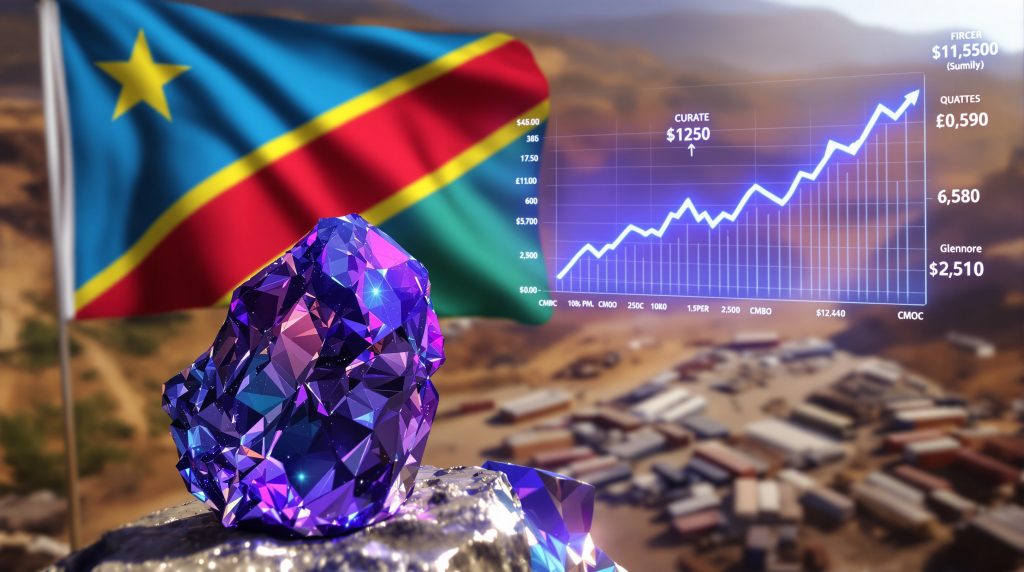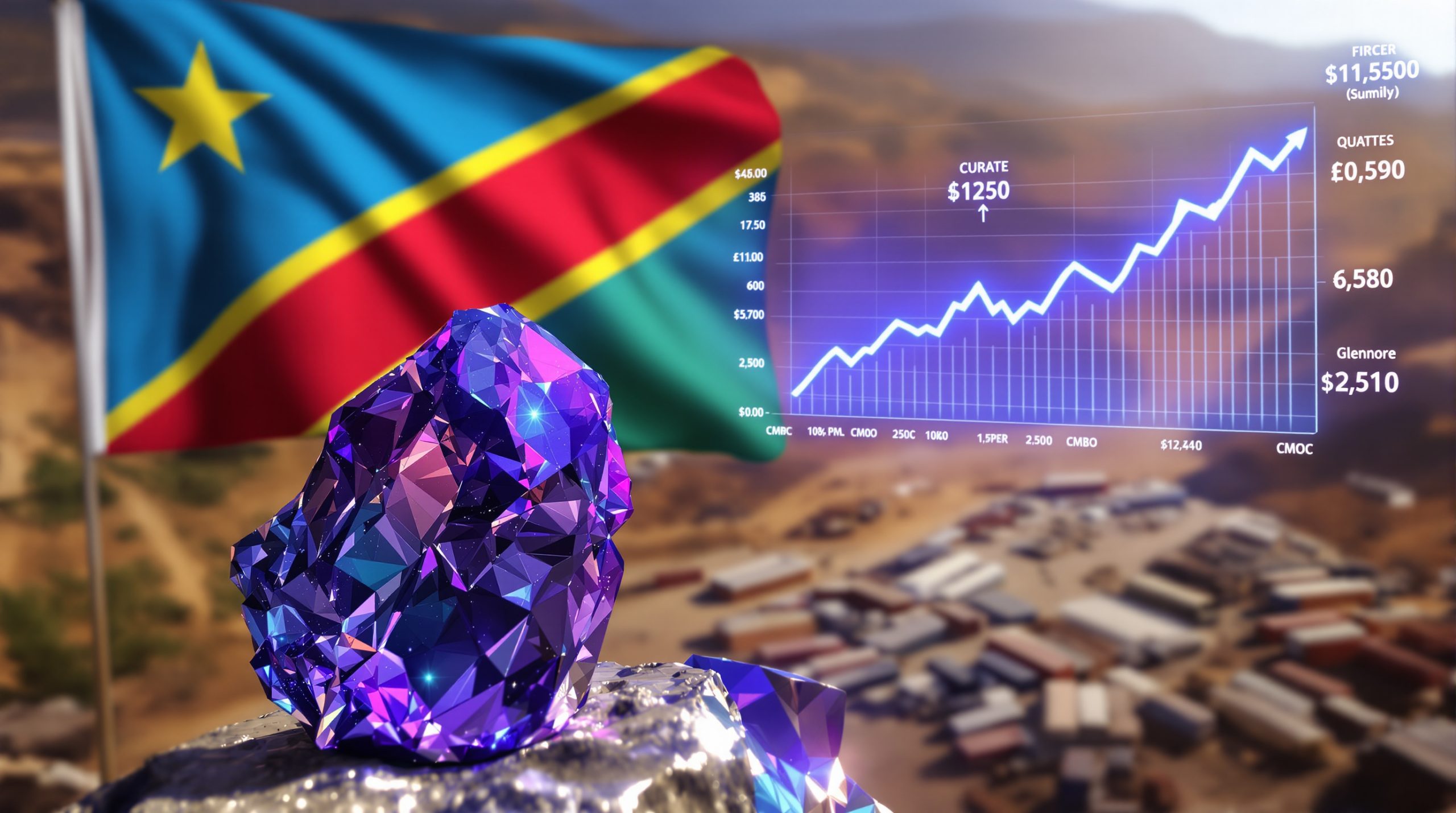Congo's Cobalt Export Quotas: A Transformative Approach to Resource Control
The Democratic Republic of Congo (DRC) is implementing a revolutionary quota-based system for cobalt exports that will fundamentally transform the global supply chain for this critical battery metal. After imposing a months-long export ban to address oversupply and influence prices, the DRC is now transitioning to a strictly regulated quota system that gives the government unprecedented control over the country's vast cobalt resources.
The Strategic Importance of Congo's Cobalt Resources
The DRC supplies approximately 70% of global cobalt production, with output reaching 130,000 metric tonnes in 2024 according to the U.S. Geological Survey. This dominance gives the country exceptional leverage in global markets, particularly as demand for electric vehicles continues to accelerate worldwide.
Cobalt remains essential for electric vehicle batteries, smartphones, and various high-tech applications. The International Energy Agency reports that lithium-ion batteries consumed approximately 77% of global cobalt demand in 2024, with electric vehicle battery production accounting for about 60% of total cobalt consumption.
The country's reserves represent the world's largest concentration of this critical minerals transition, with the DRC holding an estimated 3.6 million metric tonnes—approximately 48% of known global reserves according to recent USGS data.
What Are the Key Components of Congo's New Quota System?
The DRC's new regulatory framework introduces a carefully calibrated approach that balances market stabilization with national economic interests. The system represents the most aggressive move yet by Congo to assert control over its mineral wealth.
Quota Structure and Implementation Timeline
The new regulatory framework introduces a carefully calibrated approach to cobalt exports:
| Time Period | Total Export Quota | Monthly Allocation | Percentage of Previous Production |
|---|---|---|---|
| Q4 2025 | 18,125 tonnes | ~6,042 tonnes | Limited transition period |
| 2026-2027 | 96,600 tonnes annually | 8,050 tonnes | Approximately 74% of 2024 levels |
The quota system officially begins October 16, 2025, marking the end of the previous export ban and establishing a new paradigm for cobalt market regulation that will continue through at least 2027.
Allocation Methodology and Major Recipients
The distribution of export quotas follows a strategic approach based on historical production data, with the largest allocations going to the biggest producers:
-
Top Beneficiaries for Q4 2025:
- China Molybdenum Co. (CMOC): 6,500 tonnes (world's largest cobalt producer)
- Glencore: 3,925 tonnes (second-largest global producer)
- Remaining allocations distributed among smaller operators
-
Additional Recipients Include:
- Gecamines JV (Congo's state mining company)
- Entreprise Generale du Cobalt (EGC)
- Societe du Terril de Lubumbashi (STL)
- Deziwa JV
- Ruashi Mining
- Chemaf
- CDM (Huayou)
- Musonoi JV
According to industry analysts at CRU Group, "The quota system represents a fundamental shift from market-based supply to government-controlled allocation, giving the DRC unprecedented leverage over global cobalt prices."
Strategic Reserve and Government Control
A significant portion of the quota system is reserved for direct government control:
- 9,600 tonnes designated as a "strategic reserve" managed by ARECOMS (Congo's Strategic Mineral Substances Market Regulation and Control Authority)
- This reserve will be allocated for "projects of national importance"
- Unused monthly allocations from companies will be transferred to this strategic reserve starting January 1, 2026
ARECOMS, established under Ministerial Order No. 0023/CAB.MIN/MINES/2024 in March 2024, has broad authority over all strategic minerals including cobalt, coltan, and lithium.
What Compliance Requirements Must Companies Meet?
The DRC has established stringent compliance requirements with severe consequences for violations, creating what industry observers describe as a "use-it-or-lose-it" regime.
The "Use-It-or-Lose-It" Enforcement Mechanism
The DRC has established stringent compliance requirements with severe consequences for violations:
- Companies must utilize their full allocated export volumes
- Quotas will be revoked for:
- Failure to export allocated volumes
- Environmental regulation violations
- Tax compliance issues
- Unauthorized transfer of quotas to third parties
These enforcement mechanisms represent Congo's most aggressive move yet to assert control over its mineral resources, potentially disrupting global electric vehicle supply chains if major producers fail to comply.
Additional Regulatory Requirements
- Pre-payment of mining royalties based on monthly quotas and current cobalt prices
- Standard cobalt royalty rate: 10% of market value plus a 5% strategic minerals levy
- Traceability requirements for all exported material through the "Better Sourcing Program"
- Special restrictions on processing third-party or artisanal cobalt (with exceptions for state-backed EGC and STL)
- Automatic renewal of December 2025 allocations into 2026 only for fully compliant operators
The DRC government mandated electronic tracking systems for all mineral exports under the Better Sourcing Program launched in partnership with RCS Global in March 2024, significantly enhancing transparency in the supply chain.
How Has the Market Responded to Congo's Export Controls?
The DRC's export restrictions have already triggered market responses, though the impact has been more measured than initially expected.
Price Impact and Supply Chain Disruptions
Cobalt prices have shown moderate increases in response to the export restrictions:
- Cobalt metal prices averaged $15.85/lb in Q3 2025, according to London Metal Exchange data
- Current prices hover around $15.40/lb (Fastmarkets MB assessment, October 2025)
- This represents approximately a 7.7% increase from March 2025 prices of $14.30/lb
According to Reuters columnist Andy Home, "The DRC's quota system introduces supply uncertainty that could support prices in the medium term, but the impact depends heavily on enforcement and compliance."
Industry Resistance and Adaptation Strategies
- Foreign mining companies, particularly Chinese operators, have protested the new regulatory framework
- Battery manufacturers are accelerating their shift toward cobalt-free alternatives
- LFP (Lithium Iron Phosphate) batteries contain zero cobalt and represented 40% of global EV battery installations in 2024
- High-nickel NMC batteries have reduced cobalt content to approximately 10% of cathode weight, down from 20% in earlier chemistries
CRU Group's battery metals specialist George Heppel noted, "Chinese battery manufacturers are accelerating their shift toward LFP chemistries that contain no cobalt, partly in response to supply chain uncertainties from the DRC."
What Are the Broader Implications of Congo's Cobalt Strategy?
Congo's assertive resource policy fits into a broader global trend of resource nationalism that has emerged in critical mineral sectors worldwide.
Economic and Governance Impacts for the DRC
- The central bank projects significant revenue increases from the combined effects of higher cobalt prices and improved control over exports
- Enhanced transparency in mineral export tracking and reporting through electronic traceability systems
- Reduced fraud and unauthorized exports through stricter controls
- Greater national benefit from the country's mineral wealth through strategic reserves and quota management
The DRC Mining Code amendments in 2018 already increased royalty rates to 10% for strategic minerals like cobalt, with an additional 5% strategic minerals levy, maximizing government revenue from these resources.
Geopolitical Dimensions and Global Supply Chain Effects
- Rising resource nationalism in critical minerals sectors worldwide, with similar strategies implemented by Indonesia (nickel), Zimbabwe (lithium), and the South American "Lithium Triangle"
- Intensified competition between major powers for access to battery materials
- Potential acceleration of supply chain diversification efforts outside Africa
- Increased investment in cobalt project expansion in politically stable jurisdictions
According to Dr. Benjamin Sovacool, Professor of Energy Policy at the University of Sussex, "Resource nationalism in critical minerals reflects producer countries' growing awareness of their bargaining power in the energy transition, but risks triggering supply chain diversification that could ultimately reduce their market influence."
Market Forecasts and Future Scenarios
- S&P Global Commodity Insights projects modest but sustained price growth for cobalt
- Structural deficit in the global cobalt market likely to persist through 2027
- Potential for market rebalancing if substitution accelerates or new production comes online
- Development of recycling initiatives expected to recover increasing amounts of cobalt from spent batteries
Simon Moores, CEO of Benchmark Mineral Intelligence, stated that "The DRC's quota system will likely accelerate investment in cobalt projects outside Africa, particularly in Australia, Canada, and the Philippines."
How Might Congo's Quota System Evolve?
The DRC's regulatory framework includes several mechanisms for adaptation and flexibility, suggesting authorities recognize the need to balance market control with economic pragmatism.
Potential Adjustments and Policy Flexibility
The DRC's regulatory framework includes mechanisms for adaptation:
- Government reserves the right to purchase excess cobalt stocks beyond company quotas
- Quota adjustments permitted if "significant imbalance" develops in the market
- Possibility of quota increases if global demand grows substantially
- Potential for quota system extension beyond 2027
These flexibility mechanisms indicate Congo's recognition of the need to balance market control with economic pragmatism.
Long-Term Strategic Considerations
- Development of domestic processing and refining capacity through $300 million in tax incentives for cobalt processing facilities
- Potential for value-added manufacturing within the DRC to capture more of the supply chain
- Integration with broader African mineral development initiatives
- Balancing revenue maximization with sustainable production levels
Current DRC refining capacity is approximately 30,000 tonnes cobalt metal equivalent per year, primarily through Chinese-owned operations, but the government has ambitious plans to increase this capacity significantly.
What Should Stakeholders Monitor Going Forward?
Market participants across the battery metals supply chain will need to closely monitor several key indicators to assess the full impact and evolution of Congo's critical minerals strategy.
Key Indicators and Milestones
- Actual enforcement of quota revocation for non-compliant companies
- Monthly export compliance rates and quota utilization percentages
- Strategic reserve accumulation rates over time
- Price differentials between DRC domestic market and international pricing
- Battery chemistry adoption trends (LFP vs. NMC market share)
- Development timelines for cobalt projects outside the DRC
CRU Group analysts recommend tracking: "Monthly export volumes versus quotas, price spreads between DRC and international markets, and battery manufacturers' inventory levels as key indicators of the quota system's effectiveness."
Critical Questions for Market Participants
- Will the quota system achieve the DRC's economic and market influence goals?
- How will major consumers adapt to higher prices and restricted supply?
- What technological alternatives might emerge to reduce cobalt dependence?
- How will geopolitical tensions impact access to Congo's cobalt resources?
Alternative cobalt sources under development include Jervois Global's Idaho Cobalt Operations (USA), targeting 1,500 tonnes per year refined cobalt production with an expected restart in Q2 2026, and Fortune Minerals' NICO Project in Canada with an estimated 1,728 tonnes per year cobalt production capacity.
FAQ: Congo's Cobalt Export Quotas
Why has Congo implemented export quotas instead of continuing the ban?
The quota system provides greater market predictability while still allowing the DRC to maintain control over supply volumes and influence global prices. It represents a more sustainable long-term approach compared to a complete export ban, which risked driving development of alternative sources and technologies.
How will the quotas affect electric vehicle production globally?
The restricted supply may increase battery costs in the short term, potentially impacting EV production economics. However, it may also accelerate research into cobalt-reduced battery technologies and alternative chemistries, which could benefit the industry in the longer term.
Can companies appeal quota revocations?
The regulatory framework does not explicitly outline an appeals process, suggesting that ARECOMS decisions regarding quota revocation may be final. Companies may need to pursue diplomatic channels or legal options if they face quota revocation.
Will the quota system lead to increased illegal exports?
The strict enforcement mechanisms and traceability requirements aim to prevent unauthorized exports. The electronic tracking systems implemented under the Better Sourcing Program significantly enhance the government's ability to monitor the supply chain and reduce illegal exports.
How might battery manufacturers respond to restricted cobalt supplies?
Responses will likely include securing long-term supply contracts, investing in recycling technologies, developing cobalt-reduced battery chemistries like high-nickel NMC formulations, and exploring alternative sources outside the DRC. The trend toward LFP batteries, which contain no cobalt, may also accelerate, particularly in cost-sensitive vehicle segments.
Further Exploration
Stakeholders interested in learning more about global cobalt markets and supply chain dynamics can explore additional perspectives on mining industry evolution and market developments through industry publications, market intelligence providers, and regulatory updates from the DRC government.
The continuing evolution of Congo's resource management strategies will have significant implications for global energy transition efforts and the future of electric mobility worldwide.
Want to Stay Ahead of Major Mineral Discoveries?
Discover actionable mining investment opportunities in real-time with Discovery Alert's proprietary Discovery IQ model, delivering instant notifications of significant mineral discoveries on the ASX. Visit their discoveries page to see how early investors capitalise on major mineral finds before the broader market.




